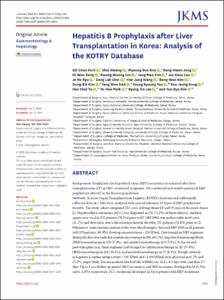Hepatitis B Prophylaxis after Liver Transplantation in Korea: Analysis of the KOTRY Database
- Affiliated Author(s)
- 강구정
- Alternative Author(s)
- Kang, Koo Jeong
- Journal Title
- Journal of Korean medical science
- ISSN
- 1598-6357
- Issued Date
- 2020
- Keyword
- Hepatitis B Virus; Recurrence; Liver Transplantation; Hepatitis B Immunoglobulin; Antiviral Agent
- Abstract
- Background:
Prophylaxis for hepatitis B virus (HBV) recurrence is essential after liver transplantation (LT) in HBV-associated recipients. We conducted real-world analysis of HBV prophylaxis after LT in the Korean population.
Methods:
Korean Organ Transplantation Registry (KOTRY) database and additionally collected data (n = 326) were analyzed with special reference to types of HBV prophylaxis.
Results:
The study cohort comprised 267 cases of living-donor LT and 59 cases of deceased-donor LT. Hepatocellular carcinoma (HCC) was diagnosed in 232 (71.2%) of these subjects. Antiviral agents were used in 255 patients (78.2%) prior to LT. HBV DNA was undetectable in 69 cases (21.2%) and detectable over wide concentrations in the other 257 patients (78.8%) prior to LT. Polymerase chain reaction analysis of the store blood samples detected HBV DNA in all patients, with 159 patients (48.9%) showing concentrations > 100 IU/mL. Post-transplant HBV regimens during the first year included combination therapy in 196 (60.1%), hepatitis B immunoglobulin (HBIG) monotherapy in 121 (37.1%), and antiviral monotherapy in 9 (2.8%). In the second post-transplant year, these regimens had changed to combination therapy in 187 (57.4%), HBIG monotherapy in 112 (34.4%), and antiviral monotherapy in 27 (8.3%). Trough antibody to hepatitis B surface antigen titers > 500 IU/mL and >1,000 IU/mL were observed in 61.7% and 25.2%, respectively. The mean simulative half-life of HBIG was 21.6 ± 4.3 days with a median 17.7 days. Up to 2-year follow-up period, HCC recurrence and HBV recurrence developed in 18 (5.5%) and 6 (1.8%), respectively. HCC recurrence developed in 3 of 6 patients with HBV recurrence.
Conclusion:
Combination therapy is the mainstay of HBV prophylaxis protocols in a majority of Korean LT centers, but HBIG was often administered excessively. Individualized optimization of HBIG treatments using SHL is necessary to adjust the HBIG infusion interval.
- Department
- Dept. of Surgery (외과학)
- Publisher
- School of Medicine (의과대학)
- Citation
- Gil-Chun Park et al. (2020). Hepatitis B Prophylaxis after Liver Transplantation in Korea: Analysis of the KOTRY Database. Journal of Korean medical science, 35(6), e36. doi: 10.3346/jkms.2020.35.e36
- Type
- Article
- ISSN
- 1598-6357
- Appears in Collections:
- 1. School of Medicine (의과대학) > Dept. of Surgery (외과학)
- 파일 목록
-
-
Download
 oak-2020-0420.pdf
기타 데이터 / 2.21 MB / Adobe PDF
oak-2020-0420.pdf
기타 데이터 / 2.21 MB / Adobe PDF
-
Items in Repository are protected by copyright, with all rights reserved, unless otherwise indicated.